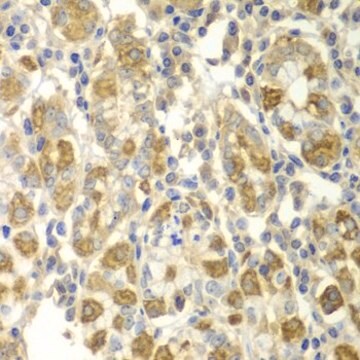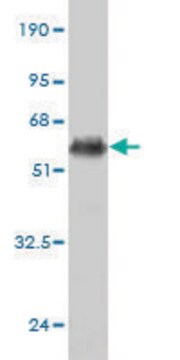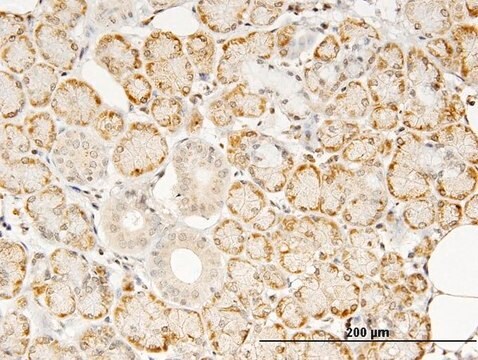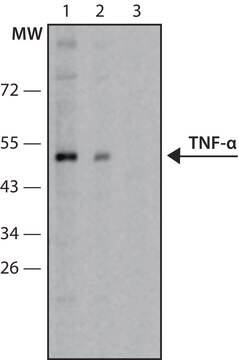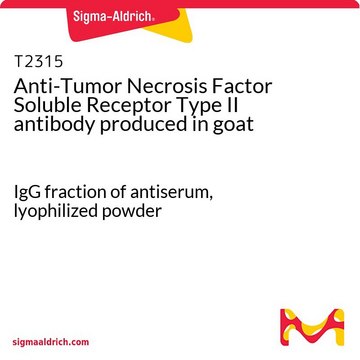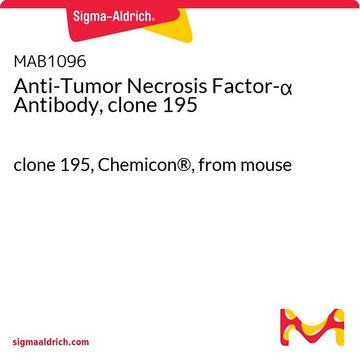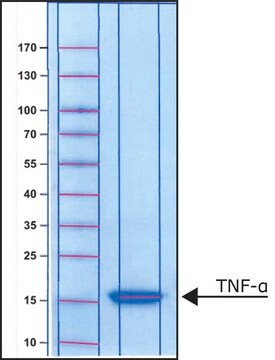T3198
Monoclonal Anti-Tumor Necrosis Factor-α antibody produced in mouse
clone 45418.111, purified immunoglobulin, lyophilized powder
Synonyme(s) :
Anti-TNF-α
About This Item
Produits recommandés
Source biologique
mouse
Niveau de qualité
Conjugué
unconjugated
Forme d'anticorps
purified immunoglobulin
Type de produit anticorps
primary antibodies
Clone
45418.111, monoclonal
Forme
lyophilized powder
Espèces réactives
rat
Technique(s)
capture ELISA: suitable
neutralization: suitable
western blot: 1-2 μg/mL
Isotype
IgG1
Numéro d'accès UniProt
Température de stockage
−20°C
Modification post-traductionnelle de la cible
unmodified
Informations sur le gène
rat ... Tnf(24835)
Description générale
Immunogène
Application
Actions biochimiques/physiologiques
Tumor necrosis factor-α (TNFα) affects various cellular processes such as blood-brain barrier, inflammatory, thrombogenic and vascular changes following brain damage. TNFα expression is upregulated in various central nervous system disorders, including Alzheimer′s disease, multiple sclerosis, Parkinson′s disease, meningococcal meningitis and human immunodeficiency virus (HIV) infection. Elevated expression of TNFα in the brain and blood in response to lipopolysaccharide might increase brain stem thrombosis, hemorrhage and stroke sensitivity/risk in hypertensive rats. Tumor necrosis factor-α activates polymorphonuclear leukocyte NADPH oxidase, thereby facilitates development of systemic oxidative stress (OS), inflammation and hypertension in rats.
Forme physique
Clause de non-responsabilité
Vous ne trouvez pas le bon produit ?
Essayez notre Outil de sélection de produits.
Code de la classe de stockage
11 - Combustible Solids
Classe de danger pour l'eau (WGK)
WGK 3
Point d'éclair (°F)
Not applicable
Point d'éclair (°C)
Not applicable
Équipement de protection individuelle
Eyeshields, Gloves, type N95 (US)
Faites votre choix parmi les versions les plus récentes :
Déjà en possession de ce produit ?
Retrouvez la documentation relative aux produits que vous avez récemment achetés dans la Bibliothèque de documents.
Notre équipe de scientifiques dispose d'une expérience dans tous les secteurs de la recherche, notamment en sciences de la vie, science des matériaux, synthèse chimique, chromatographie, analyse et dans de nombreux autres domaines..
Contacter notre Service technique